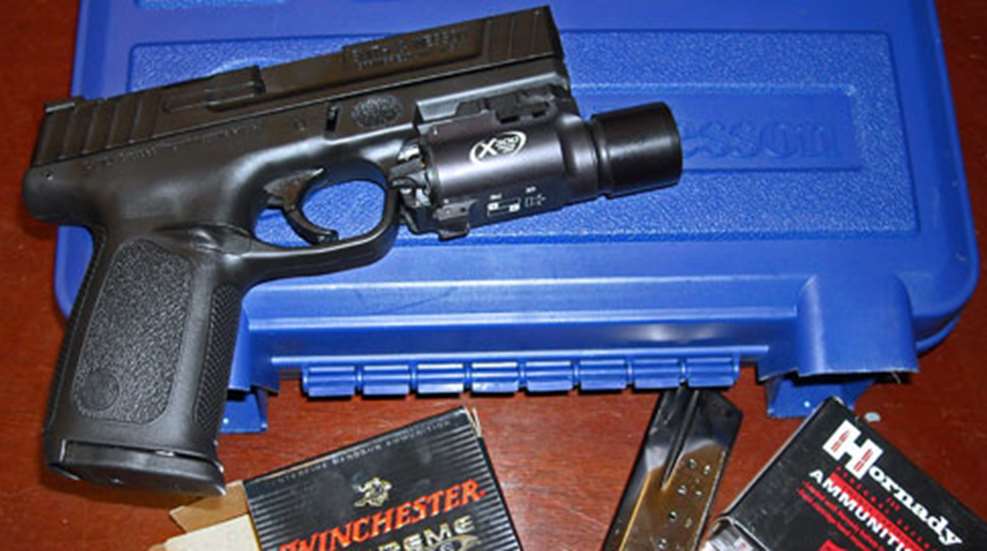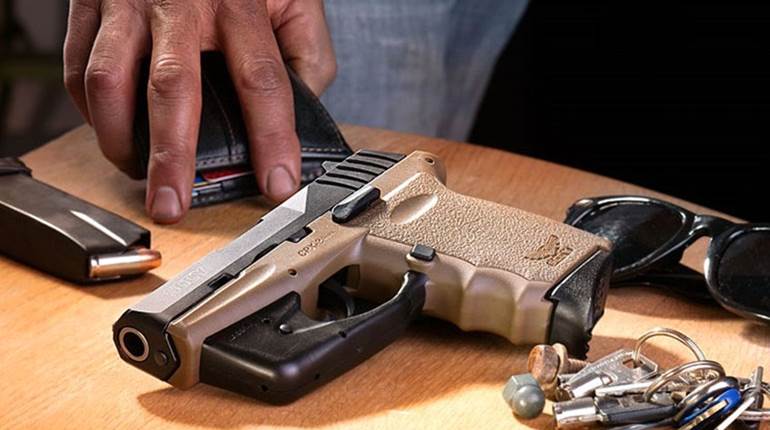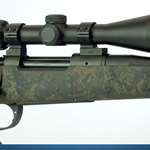
Since the early 1990s, firearm manufacturers have been producing polymer semi-auto pistols in a variety of calibers for both law enforcement and self-defense markets. These “plastic” pistols have become highly popular over the years because of their simplicity and reliability.
Many law enforcement agencies are issuing some type of striker-fired polymer handgun because the guns are accurate, affordable and, most importantly, easy to use, which also translateswell for the home-defense gun owner.
Smith & Wesson has been covering both the high and low ends of the polymer-gun price spectrum with its M&P and Sigma lines, respectively. Then, during the 2010 NRA Annual Meetings & Exhibitsin Charlotte, S&W introduced a mid-range polymer pistol to meet the needs of the home and self-defense shooter.
“If you look at our polymer pistol line, we had the Sigma, which was a price-point polymer, and we had the full-featured M&P duty gun,” said Jim Unger, S&W product manager. “There was a $200 gap between the two and a huge difference in features. We wanted a gun that hit in the middle and provided the features needed for self-defense.”
Self-defense is the entire theme of the SD Series as it’s available in two effective self-defense calibers—9 mm and .40 S&W—along with multiple features popular with the self-defense crowd such as a 4-inch barrel, Trijicon front sight, white-dot rear sights, loaded chamber indicator and an accessory rail for attaching a light, laser or even a bayonet. The SD also comes with a black Melonite finish to reduce glare, which according to S&W provides a surface hardness of 68 on the Rockwell scale.
The grips are fairly slim and ergonomic with a good angle—18 degrees—for both point shooting and aimed fire with aggressive diamond-shaped checkering on the front and backstraps and rough texture on the sides. Serrations on the slide are deep and slightly angled toward the muzzle providing a good gripping surface for chambering a round. Just below the steel slide is a textured finger locator to help shooters keep their fingers off the trigger until the pistol is lined up on the target and ready to fire.
Both the SD9 and SD40 have an unloaded weight of 22.7 ounces and come with two high-capacity magazines—the 9 mm version holds 16+1 rounds while the 40 S&W contains 14+1 rounds—or two California-legal 10+1 round mags. Both versions come with S&W’s lifetime service policy.
While the night sight, checkering and rail are all good for both carry and home-defense guns, according to Unger, the most interesting feature is the Self Defense Trigger. The SDT was designed to provide a smooth, consistent trigger pull every time, which enhances confidence by improving accuracy for the user.
“The self-defense trigger is light enough to be accurate, but not too light,” said Unger. “The front sight is nice, but having a trigger designed for self-defense makes all the difference in the world to people fighting for their life.”
The SD series contains no manual safety. Instead, its only visible safety is on the bottom half of the trigger, which must be depressed before the striker can be engaged. A sear prevents the striker from hitting the primer unless the trigger is depressed. The striker is brought fully to the rear with each trigger pull before releasing and striking the primer. Because of the safety, the trigger has a slight amount of rearward play before engaging the striker, but once engaged, the trigger pull becomes very even, breaking at just over 8 pounds on the test model.
In accuracy testing, the SD40 performed OK. Since the gun is designed for self-defense, accuracy was checked using Cor Bon, Federal, Hornady and Winchester self-defense rounds applying the American Rifleman standard of five groups of five shots from a bench at 25 yards. In addition, I shot one 10-round group at 25 yards with each load. All shot well with the Federal 135-grain Hydro-Shok performing best by averaging just under 4 inches in the five 5-shot groups. The 10-shot groups obviously opened up, but easily stayed within the limits of aself-defense grouping.
In addition to accuracy testing, I decided a self-defense handgun needed to run through some self-defense drills to learn its true potential. To do so, I dimmed the range lights to perform low-light drills both with and without an attached light.
With a SureFire X300 Weapon Light, it was easy to see both the target and the sights, and the added weight on the front helped with muzzle rise providing for faster follow-up shots. Of course, since the SD40 comes with a Trijicon front sight, the real test was conducted without a light. In even the faintest light or pure darkness, the tritium front sight was clearly visible. At the same time, the white-dot rear sights stood out fairly well if there was some light, which provided a good sight picture for firing. However, as the room became darker, the rear sights were practically useless. Since I wouldn’t fire at an unknown target anyway, this wasn’t very concerning.
Throughout it all, the SD40 never malfunctioned with more than 300 rounds fired in a variety of both speed and action drills. This bodes well, as the most important requirement of a self-defense handgun is reliability.
Overall, the SD40 performed well. Reliability, feel and function were terrific, while accuracy was just acceptable. I didn’t get great groups with and no matter how I shot—bench, standing or drills—or the type of ammunition used, the SD40 shot low. At 25 yards, the difference between aim and shot was about 3 to 4 inches. As I decreased the range, the difference obviously lessened, but regardless of range, the SD40 shot low enough in my hands to be apparent.
The SD has a solid feel to it with a good grip angle. It’s easy to use and has many features of the M&P along with a much better trigger than the Sigma. However, S&W claims the SD Series is not a combination of the two.
“There is not a lot of commonality between the two in reality,” said Unger. “When describing the polymer guns to dealers, we lay out the features of all three and compare them to one another. This was a fresh sheet of paper.”
Manufacturer: Smith & Wesson, www.smithandwesson.com
Caliber: 9 mm and .40 S&W (tested)
Action: striker-fired semi-auto pistol
Frame: polymer lower, steel upper
Finish: Black Melonite
Barrel: 4”
Rifling: 1:18.75” right-hand twist
Magazine: two high-capacity (16+1 9 mm, 14+1 .40 S&W) or two 10+1
Sights: Trijicon front, white-dot rear
Trigger Pull: 8 lbs., 2 oz.
Overall Length: 7.1”
Width: 1.29”
Weight: 22.79 oz.
Accessories: hardcase, two magazines, instruction manual and safety lock
Suggested Retail Price: $530





































